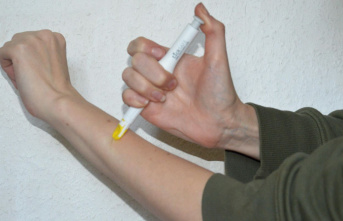At the announcement of cancer, what until then seemed essential can suddenly become futile as the benchmarks and certainties are jostled. Faced with a now very vague future, the question of work, which concerns 30% of patients at the time of diagnosis (1), can often take a back seat. In general, patients do not wish to work during their illness. “Still very strong a few years ago, this trend nevertheless seems to be attenuating somewhat thanks to the constant evolution of treatments, and in particular the rise of targeted therapies, which have made it possible both to increase hope of life, but also to reduce the side effects of chemotherapy and other treatments for the disease", observes Dr Évelyne Renault-Tessier, doctor specializing in chronic pain and palliative care and director of the transversal Therapeutic Education Unit of the patient (Utep) from the Institut Curie (Paris).
A chance for those who do not plan to give an inch of ground to the disease while their files accumulate. However, it is clear that they represent only a minority of people who are found more among business leaders, managers and in all positions of responsibility. For the vast majority of employees, more than a source of real satisfaction, work remains above all an essential synonym of social status and financial income. It is still necessary that the disease allows it.
"There are nearly 200 different cancers that will progress to various stages," says Dr. Renault-Tessier. For effective care, it is necessary to adapt to the uniqueness of each without relegating the social aspect to later. It is also necessary to know how to listen to a patient explaining that he is financially dependent on his work and that State aid will not suffice in the event of excessively prolonged sick leave, especially since the latter is not always medically justified. However, even well anticipated, the return to work remains a difficult period, especially when there is a gap between expectations and reality. For example, radiotherapy is a first-line treatment for cancers which is sometimes combined with a professional activity. But it can become insufficient and need to be supplemented by chemotherapy with significant side effects (fatigue, nausea, vomiting, hair loss, etc.). A protocol that ends up excluding practically all possibilities of continuing to work.
Surgery, on the other hand, can leave significant physical and psychological consequences, which will not necessarily allow you to resume your previous activity. Not to mention difficulty concentrating or performing routine tasks, memory lapses, the feeling of confusion of the mind or “brain fog”. This symptom, also called "chemobrain", following oncological treatments, can cause real distress in stressful jobs in the absence of cognitive rehabilitation. "You have to be particularly vigilant when the desire to find your job is stronger than the real capacities", warns Nathalie Vallet-Renart, co-founder and general manager of Enterprise and Cancer, an associative structure whose objective is to promote the maintenance and the return to work of people with cancer. Affected by the disease herself in 2010, she has since made it a strength and supports around twenty patients a year within this association.
Is it reasonable to immediately return to full-time work? Should job adaptations be planned? Should you talk to your employer?… “Once the patient has taken the time to accept the diagnosis and the emotions it generates, he must ask himself all these questions as soon as possible, believes Nathalie Vallet-Renart. Certainly, when we look at the statistics, 80% of employees resume their activity within 2 years after the diagnosis and 80% of people are employed 5 years after the announcement. But these figures accrediting an effective return to work are misleading, because they say nothing about the conditions under which the employee returns to his post...” Also, adjusting the treatments as well as possible in order to leave free periods reserved for work and compatible with the treatment protocol established is an essential objective in the public health challenge of the fight against cancer.
But a lack of knowledge of the treatments, of their physical and psychological repercussions and of the rights of the patient in terms of support still too often leaves all the actors of the work confronted with this return (occupational medicine, employers, employees, etc.) quite helpless. It is therefore not surprising that the ten-year strategy for the fight against cancer 2021-2030 continues to give priority to maintaining and returning to employment initiated by the cancer plan 2014-2019. Because, even if therapeutic advances make it more and more possible to continue working, the onset of the disease degrades career prospects. Thus, among people working when the diagnosis was announced, 1 in 3 people lost or left their job within 2 years (2). As for those who keep their jobs, many of them admit to feeling penalized by refusals of promotion or loss of responsibilities.
Here are 5 ways not to be overlooked to help regain self-confidence in a work environment where, most often, everything is standardized, supervised, quantified. A space in which the patient seems to exist at his true value.
maintain the link
Maintaining the link between the employee suffering from cancer and his company, in particular through his colleagues, is an essential element in facilitating the return to work. However, as the Mosaic Cancer association (3) reminds us, 20% of people suffering from cancer do not maintain any ties with their company during their work stoppage. A detrimental attitude that further alienates the employee on his return. In fact, in their absence, sometimes for several months, the professional environment will necessarily have changed. Retirements, changes of position, promotions… These novelties often rhyme with anxiety for the person returning after sick leave.
Anticipate
The pre-recovery visit must be carried out as soon as possible when you want or can return to work, so that the workstation arrangements can be put in place. According to a relatively recent study (4), in 92% of cases no contact took place between occupational medicine and the healthcare teams, and there was no pre-recovery visit - not compulsory, it is true - only in 25% of cases. Which is very regrettable, because this visit, provided for by the labor code for employees of the general and agricultural system, aims to facilitate social and professional reintegration.
Don't put pressure on yourself
Returning to work should not be like an injunction, at the risk of spoiling your recovery period. You have to agree to take time for yourself in times of fragility. In addition, the disease can modify the relationship to professional activity. We have the right to change our life by deciding to opt, for example, for training or a new job.
Dare to bring the disease into the company
We are barely beginning to emerge from the taboo of cancer, but the disease retains a very negative social representation. You have to talk about it to fight against the negative images and fears it conveys, and to encourage your company to address the subject of cancer in the workplace. Almost unwittingly, the patient becomes an “expert” patient who can play an active role in moving from case-by-case management of these situations to equal treatment of all employees confronted with the disease.
Get help
You should not hesitate to call on various resource people by directly addressing your manager, the person in charge of the Mission Handicap or, if there is none, as is the case in small businesses, to competent bodies (social worker, health insurance fund, Agefiph, etc.).
(1) INCa, June 2018.
(2) 2013 report of the Societal Cancer Observatory published by the League Against Cancer, 2014.
(3) Viavoice study, 2013.
(4) Cancer and work survey 2017-2018.
The pre-recovery visit
Medical examination carried out by the occupational physician, this visit makes it possible to assess the compatibility between the abilities of the sick person and his position after a sick leave of more than three months. It can be initiated by the employee, the medical adviser or the attending physician. Not to be confused with the return visit, mandatory and at the initiative of the employer, which is done within 8 days after returning to the workplace.
The status of disabled worker
Temporary or permanent, physical and/or psychological after-effects can pave the way for Disabled Worker Quality Recognition (RQTH) awarded for one year, renewable. This system allows the company to mobilize financial aid from the Association for the management of the fund for the integration of disabled people (Agefiph) for the development of workstations and thus promote job retention.
The organization of working time
The procedures for returning to work must be organized in a multidisciplinary manner with the occupational physician, human resources, the employee concerned, the manager and possibly a coach. Its success is based on the good articulation of the triptych that constitutes the attending physician, the occupational physician and the oncologist. This can be, for example, a therapeutic half-time, a therapeutic part-time or teleworking days.
Reclassification
In the event of incapacity to occupy the post noted by the occupational doctor, the employer has the obligation to reclassify the employee in accordance with a certain number of conditions. In certain cases (invalidity, early retirement, etc.), the employer may be exempted from this obligation. In the event of dismissal for incapacity, a skills assessment and training can help to convert to a profession more suited to their state of health.












